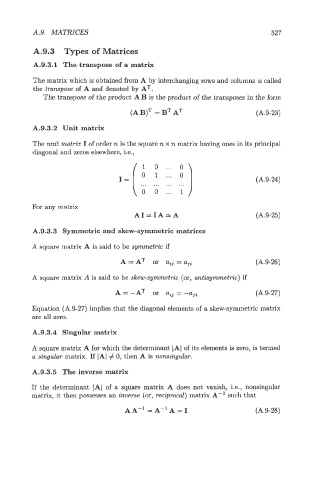Page 547 - Modelling in Transport Phenomena A Conceptual Approach
P. 547
A.9. MATRICES 527
A.9.3 Types of Matrices
A.9.3.1 The transpose of a matrix
The matrix which is obtained from A by interchanging rows and columns is called
the transpose of A and denoted by AT.
The transpose of the product AB is the product of the transposes in the form
(AB)T = BT AT (A.9-23)
A.9.3.2 Unit matrix
The unit matrix I of order n is the square n x n matrix having ones in its principal
I=( 0. .:. 0 ::: ;.) (A.9-24)
diagonal and zeros elsewhere, i.e.,
1 0 ...
...
0
For any matrix
AI=IA=A (A.9-25)
A.9.3.3 Symmetric and skew-symmetric matrices
A square matrix A is said to be symmetric if
A = AT or aij = aji (A.9-26)
A square matrix A is said to be skewsymmetric (or, antisymmetric) if
A= -AT or aij = -a,. 3% (A.9-27)
Equation (A.9-27) implies that the diagonal elements of a skew-symmetric matrix
are all zero.
A.9.3.4 Singular matrix
A square matrix A for which the determinant IAl of its elements is zero, is termed
a singular matrix. If IAI # 0, then A is nonsingular.
A.9.3.5 The inverse matrix
If the determinant JAl of a square matrix A does not vanish, i.e., nonsingular
matrix, it then possesses an inverse (or, reciprocal) matrix A-l such that
AA-'=A-~A=I (A.9-28)

